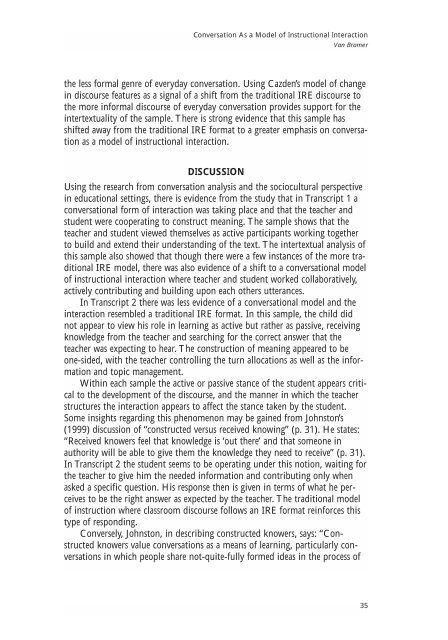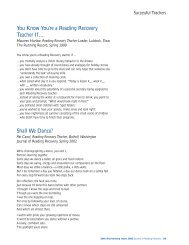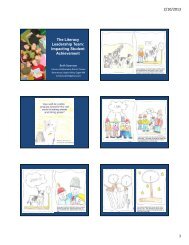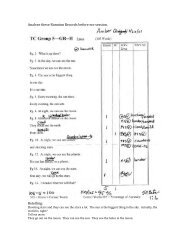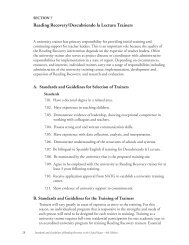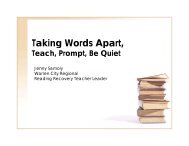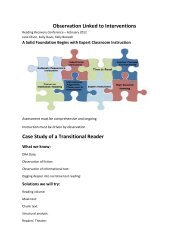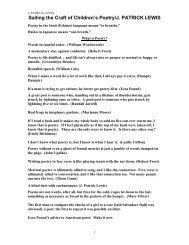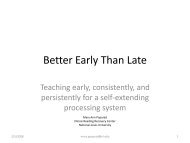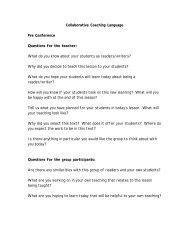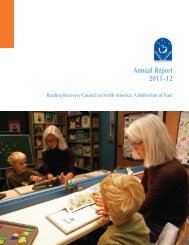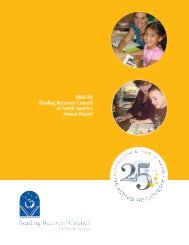Conversation As a Model of Instructional Interaction - Eric
Conversation As a Model of Instructional Interaction - Eric
Conversation As a Model of Instructional Interaction - Eric
You also want an ePaper? Increase the reach of your titles
YUMPU automatically turns print PDFs into web optimized ePapers that Google loves.
layout-8/l-2003 1/7/04 12:29 PM Page 35<strong>Conversation</strong> <strong>As</strong> a <strong>Model</strong> <strong>of</strong> <strong>Instructional</strong> <strong>Interaction</strong>Van Bramerthe less formal genre <strong>of</strong> everyday conversation. Using Cazden’s model <strong>of</strong> changein discourse features as a signal <strong>of</strong> a shift from the traditional IRE discourse tothe more informal discourse <strong>of</strong> everyday conversation provides support for theintertextuality <strong>of</strong> the sample. There is strong evidence that this sample hasshifted away from the traditional IRE format to a greater emphasis on conversationas a model <strong>of</strong> instructional interaction.DISCUSSIONUsing the research from conversation analysis and the sociocultural perspectivein educational settings, there is evidence from the study that in Transcript 1 aconversational form <strong>of</strong> interaction was taking place and that the teacher andstudent were cooperating to construct meaning. The sample shows that theteacher and student viewed themselves as active participants working togetherto build and extend their understanding <strong>of</strong> the text. The intertextual analysis <strong>of</strong>this sample also showed that though there were a few instances <strong>of</strong> the more traditionalIRE model, there was also evidence <strong>of</strong> a shift to a conversational model<strong>of</strong> instructional interaction where teacher and student worked collaboratively,actively contributing and building upon each others utterances.In Transcript 2 there was less evidence <strong>of</strong> a conversational model and theinteraction resembled a traditional IRE format. In this sample, the child didnot appear to view his role in learning as active but rather as passive, receivingknowledge from the teacher and searching for the correct answer that theteacher was expecting to hear. The construction <strong>of</strong> meaning appeared to beone-sided, with the teacher controlling the turn allocations as well as the informationand topic management.Within each sample the active or passive stance <strong>of</strong> the student appears criticalto the development <strong>of</strong> the discourse, and the manner in which the teacherstructures the interaction appears to affect the stance taken by the student.Some insights regarding this phenomenon may be gained from Johnston’s(1999) discussion <strong>of</strong> “constructed versus received knowing” (p. 31). He states:“Received knowers feel that knowledge is ‘out there’ and that someone inauthority will be able to give them the knowledge they need to receive” (p. 31).In Transcript 2 the student seems to be operating under this notion, waiting forthe teacher to give him the needed information and contributing only whenasked a specific question. His response then is given in terms <strong>of</strong> what he perceivesto be the right answer as expected by the teacher. The traditional model<strong>of</strong> instruction where classroom discourse follows an IRE format reinforces thistype <strong>of</strong> responding.Conversely, Johnston, in describing constructed knowers, says: “Constructedknowers value conversations as a means <strong>of</strong> learning, particularly conversationsin which people share not-quite-fully formed ideas in the process <strong>of</strong>35


